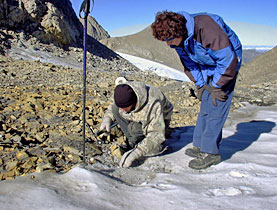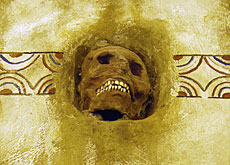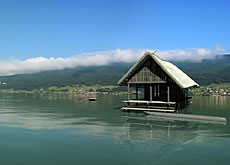New details emerge about Neolithic age in Alps

Scientists say some of the prehistoric finds made in the Swiss Alps over the past few years are 1,000 years older than Austria's sensational "Ötzi the Iceman".
Archaeologists said in Bern on Thursday that the oldest of the organic materials uncovered on the Schnidejoch pass date back to 4,500 BC.
Radiocarbon dating of 46 of the more than 300 objects revealed that they were 1,500 years older than previously thought.
“We know now that the finds in the ice are the oldest of their kind in the Alps,” said Albert Hafner of canton Bern’s archaeological service.
The artefacts include leather remnants of shoes and leggings, as well as a bow, arrow shafts and arrowheads – and the 1.6 metre long birch bark holder they were carried in.
All that is missing is the body – or any remains – of the owner of the hunting gear.
“We think this person had an accident but there’s been no trace of the person up to now,” Hafner told swissinfo.
“There’s still a small chance that there’s a corpse in the ice. But all the Neolithic objects were found rather far from the remaining ice patch so the probability of finding a body is very low, but it can still happen.”
It would cause a small sensation if a Swiss Ötzi or even a few human bones were to emerge from the ice, but the artefacts already found have shed new light on our understanding of the Neolithic age in the Alps.
Missing link
According to Hafner, the Schnidejoch finds are quite literally the missing piece of the puzzle linking the Neolithic lake – or pile – dwellings of northern Switzerland with the settlements from the same epoch in the Rhone valley to the south of the pass.
He said the pile dwellings provide insights into daily life of the period, whereas the megalithic necropolis in Sion reveals much about its culture. Now the Schnidejoch finds show how Neolithic man travelled.
“We’re seeing preserved organic material for the first time and that’s what’s exciting about the work going on here in Switzerland,” Canadian archaeologist, Gregory Hare, a speaker at the Bern University conference, told swissinfo.
“In North America, archaeologists are typically working on stone tools which gives a very limited picture of the past,” Hare explained.
DNA
“But with material preserved in the ice we get tremendous organic information that previously hadn’t been available so you’re able to do things like DNA research, and chemical analysis of different kinds of things that previously hadn’t been found, so it’s opened many new chapters into research of the past.”
The Schnidejoch artefacts together with Ötzi’s clothing are two of the three oldest leather finds from Europe but the best preserved thanks to the ice, and therefore with much of their DNA code intact.
Expert Angela Schlumbaum told the conference that DNA analysis proved that the 5,000-year-old Schnidejoch leggings were not only made of goatskin, but also from a breed previously believed only to be common to east Asia.
“No, it didn’t come from China,” Schlumbaum joked; saying the results of the test may indicate that there was considerable goat diversity in Europe at the time “with different regional patterns than today”.
Glacier reconstruction
Swiss glaciologists have also welcomed the Schnidejoch discoveries. “They have made for the most precise reconstruction of glacier variations in the Alps in the prehistoric period,” said Martin Grosjean, head of the university’s Oeschger Centre for Climate Change Research.
“Since leather disintegrates when exposed to the sun and wind we can say that, at least at this site over a period of 6,000 years, the glaciers were never smaller than they were in 2003 [when the first finds were made],” Grosjean said.
A bounty of Roman and medieval relics left behind on the pass confirm intermittent warming periods, but, as Grosjean added, the temperature never went high enough to cause a meltdown of the Neolithic treasures icy hold.
Glaciologist Ralph Lugon from canton Valais- south of the Schnidejoch – said it was urgent to begin looking elsewhere in the Alps for long-forgotten passes, which may also teach us an invaluable lesson or two about prehistory.
Lugon pointed out that the first Schnidejoch discoveries were made by chance – by a hiker in 2003 – and a systematic, scientific approach could yield important dividends.
“Valais is one of the most glaciated parts of the Alps with the highest summits and the glaciers are receding very fast,” he told swissinfo.
“Perhaps there are some very high passes that were used by people in the past but we don’t know.”
He called for a large interdisciplinary research project linking social sciences, history, archaeology and glaciology.
Mentions of any forgotten passes in history books could point scientists in the right direction to make their next big discovery.
“In order to learn more about our heritage, the Alps, our relations with the south, it’s very important to get started immediately,” Lugon said.
swissinfo, Dale Bechtel
A Swiss hiker discovered an unusual object just below the Schnidejoch pass (2,756m) in September 2003.
She carried the birch bark artefact home and alerted the historical museum of Bern, which turned the object over to the canton’s archaeological service.
In the years to follow, archaeologists have uncovered 300 artefacts from the pass.
The Neolithic assemblage includes complete hunting gear and leather clothing.
The second group of finds dates from 300-400 years later, or from the early Bronze Age. This consisted of arrows, bronze needles and belts made of twigs.
There followed a 1,600 year hiatus with no archaeological evidence before a cluster of objects from the later Iron Age and Roman Age, including a woollen belt and more than 100 shoe nails.
A fragment of a leather shoe dates to the 8-9th century AD and a shoe repair kit to the 14-15th century.
All of the periods correlate with warm phases when the Schnidejoch was at least partially free of snow and ice.

In compliance with the JTI standards
More: SWI swissinfo.ch certified by the Journalism Trust Initiative











You can find an overview of ongoing debates with our journalists here . Please join us!
If you want to start a conversation about a topic raised in this article or want to report factual errors, email us at english@swissinfo.ch.